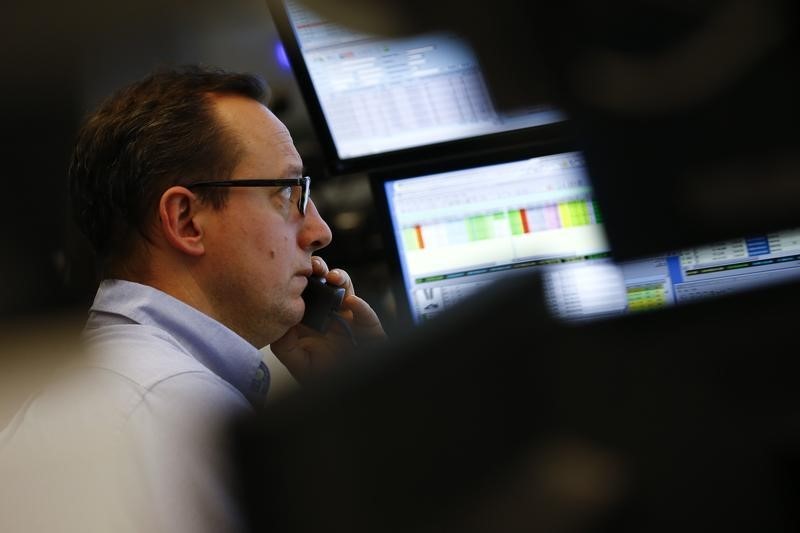This post was originally published on this site
https://i-invdn-com.akamaized.net/news/LYNXNPEC0Q1B5_M.jpg
Bank of America Corp (NYSE:BAC)., Citigroup Inc (NYSE:C)., Goldman Sachs Group Inc (NYSE:GS). and JPMorgan Chase (NYSE:JPM) & Co. each reported sharply higher first-quarter revenue from fixed-income, currencies and commodities trading compared with results in the quarter a year earlier. Citigroup led on a year-over-year basis, jumping 39% to $4.79 billion. Goldman Sachs had the biggest gain from the last three months of 2019, with FICC revenue surging by 68% to $2.97 billion.
On a conference call Wednesday, Bank of America Chief Financial Officer Paul Donofrio cited macro trading, and rates in particular, as a bright spot for the company. Citigroup said revenue from trading rates and currencies specifically jumped 56%, better than other fixed-income assets. Goldman experienced higher client flows across the board. JPMorgan highlighted its rates, currencies and emerging-market businesses while providing charts that showed rates and commodities traders were dealing with volume in March that tripled the average from January.
A month ago, this would have sounded impossible, judging by how money managers were reacting. I wrote on March 10 that the $17 trillion U.S. Treasury market was malfunctioning, with 30-year yields swinging by the most since the federal government began issuing the maturity in the 1970s. That same day, John McClain, portfolio manager at Diamond Hill Capital Management, told Bloomberg News’s Sonali Basak that in certain markets, “the traditional liquidity provider in times of stress — the bank — really isn’t there.”
Soon thereafter, Bloomberg’s John Ainger and Liz Capo McCormick (NYSE:MKC) spoke with fixed-income investors about the unprecedented volatility, who also promptly pointed fingers at the banks:
“Liquidity is still atrocious,” said Mark Holman, chief executive officer at TwentyFour Asset Management, an investment firm with about $23 billion in assets that specializes in fixed-income securities. “We were just trying on Monday to trim a long position in the 30-year Treasury because it had moved so far in our favor, and were unable to get bids from several major dealers. We’ve never seen that before.”
“I understand that dealers don’t have the risk appetite and budget they normally have,” said Holman, who has been working in financial markets since 1989. “But I’ve never seen that before, the inability to trade a U.S. Treasury.”
I don’t doubt that happened on the one day in history that the 30-year bond traded at a yield of less than 1%. At one point, the rally was so extreme that the yield touched 0.7% in what was nothing short of a broken market.
Still, it’s worth a reminder to bond traders that just because they can’t sell a security at the price they want in a highly volatile market doesn’t mean that liquidity is nonexistent. Of course dealers are going to quote much wider bid-ask spreads than normal when markets are whipsawing day after day — they need to mitigate their own risk, after all. Clearly, judging by banks’ trading revenue, they were very much open to transacting, but on their terms.
That shift in market dynamic is exactly the point of regulations set up after the 2008 financial crisis. The last thing anyone wants with markets in flux is for large banks to suddenly find themselves saddled with large losses. Bloomberg’s Michelle F. Davis put it nicely:
But the results also mark a win for regulators’ post-crisis moves, which pushed Wall Street banks to act more like middlemen and take less risk on their books. That allowed them to capitalize on volatility rather than focus on offloading bulky positions in declining markets. The firms remained well above regulatory capital minimums, even as they indicated corporate clients drew down far more than $100 billion on credit lines to weather the crisis.
Now, of course, after the Federal Reserve’s drastic intervention across bond markets, investors like Scott Minerd at Guggenheim Partners and Howard Marks at Oaktree Capital Group have turned to casting blame on the central bank for bailing out risky investments. Asset prices have stabilized from those actions and, as a result, investors can move in and out of positions at tighter prices. Now it seems as if no one cares. When it comes to liquidity, there’s no way to win in the eyes of investors.
Bank trading desks, on the other hand, look as if they’ll come out just fine either way.
This column does not necessarily reflect the opinion of Bloomberg LP and its owners.
Brian Chappatta is a Bloomberg Opinion columnist covering debt markets. He previously covered bonds for Bloomberg News. He is also a CFA charterholder.
©2020 Bloomberg L.P.

